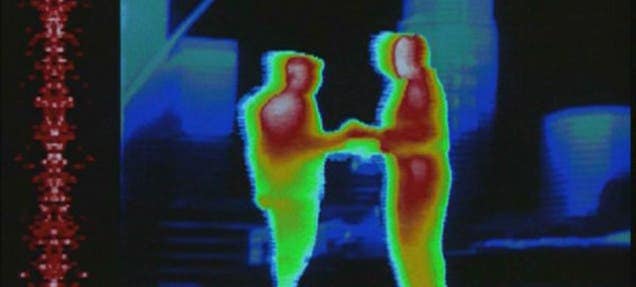As a kid, looking at the Predator movies gave me goosebumps; it wasn’t the physical superiority of the Predator, but the technological advantages. I mean, he has all that shooting stuff, and teleportation and camouflage, and the vision… it was all too much! But the way science is crazily developing, we’re already starting to experiment with all that… and I’m still in my youth ! Don’t even get me starting on the projectiles the army is experimenting with these days, and scientists have already proven different concepts of invisibility cloaks (ie here and here), researchers are working on teleportation and they’ve already successfully teleported photons, and now, thanks to graphene, guess what – we might get predator vision lenses as well.
Researchers at the University of Michigan have developed the first room-temperature light detector that can see the entire infrared spectrum of colors; and because graphene is so incredibly thin (just one atom thick), the entire device can be mounted on a smartphone, or perhaps even a contact lens.
“We can make the entire design super-thin,” said Zhaohui Zhong, assistant professor of electrical engineering and computer science told ZME Science. “It can be stacked on a contact lens or integrated with a cell phone.”
It’s all about detecting the infrared light. Infrared (IR) light is electromagnetic radiation with longer wavelengths than those of visible light, starting from wavelengths just longer than those of visible red light and stretching up to a millimeter long. Infrared vision has a lot of uses, from spotting people and animals in the dark and heat leaks in houses to monitoring blood flow and identifying some chemicals in the environment. More recently, it’s also been used in more artistic purposes, as scientists investigated the sketches behind some Gauguin paintings.
The visible spectrum can be captured with a relatively simple chip, but infrared vision requires a combination of technologies to see near-, mid- and far-infrared radiation all at once. To make things more interesting, the mid-infrared and far-infrared sensors typically need to be at very cold temperatures.
However, graphene has the capacity to detect the entire infrared spectrum – as a matter of fact, it can also detect both the visible and ultraviolet light. But until now, it hasn’t been viable for infrared detection because it can’t capture enough light to generate a detectable electrical signal. In other words, the fact that it’s so incredibly slim is both its blessing and its curse, only allowing it to capture 2.3 percent of the light that hits it. If the light that hits the graphene layer isn’t enough to generate an electric signal, then it simply can’t be used as a sensor. The researchers explain:
“The challenge for the current generation of graphene-based detectors is that their sensitivity is typically very poor,” Zhong said. “It’s a hundred to a thousand times lower than what a commercial device would require.”
In order to work this problem out, they had to think a little outside the box. Zhong and Ted Norris, the Gerard A. Mourou Professor of Electrical Engineering and Computer Science, worked with graduate students to design a new way of generating the electrical signal.
They put an insulating barrier layer between two graphene sheets. Here’s how it works (it’s a little hard to understand, but I’ll try to keep it as simple as possible): the bottom layer has a current running through it. When light hits the other layer (the top one), it frees electrons, creating positively charged holes. Then, the electrons used a quantum mechanical trick to slip through the barrier and into the bottom layer of graphene. Meanwhile, the positively charged holes, left behind in the top layer, produced an electric field that affected the flow of electricity through the bottom layer. This new approach allows a room-temperature sensor to work just as fine as the cooled mid-infrared detectors. It is also very small, which makes it even more useful.
“If we integrate it with a contact lens or other wearable electronics, it expands your vision,” Zhong said. “It provides you another way of interacting with your environment.”
Scientific Information: Graphene photodetectors with ultra-broadband and high responsivity at room temperature, Nature Nanotechnology, 2014, DOI: 10.1038/nnano.2014.31










